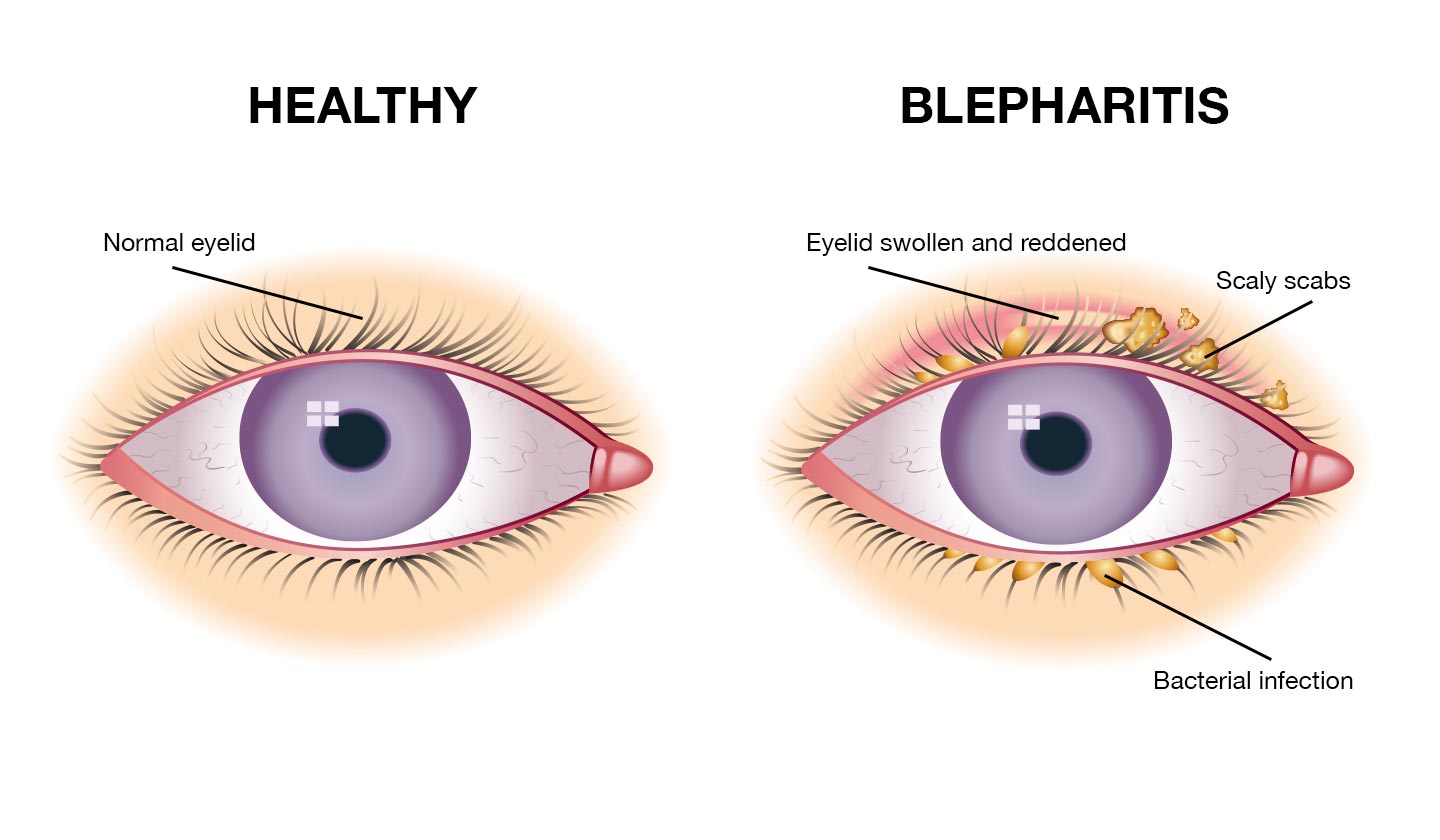Sight
Discomfort in the eyelids and dandruff on the eyelashes?
Blepharitis is an inflammation of the eyelids. It is a common cause of discomfort, itchy eyelids, red eyelids and eyelashes with dandruff.
This type of eye inflammation is very common and can affect people of all ages.
Your eye doctor can prescribe an effective treatment for blepharitis that can limit inflammation of the eyelids preventing against damage to the eyes or eyelids.
Causes of blepharitis
There are several possible causes of blepharitis, including:
- Bacterial infection of the eyelids
- Meibomian gland dysfunction (MGD)
- Dry eyes
- Fungal infection of the eyelids
- Parasites (eyelash mites - Demodex folliculorum)
Blepharitis and dry eye often occur at the same time, causing confusion as to whether dry eye gives rise to blepharitis or blepharitis gives rise to dry eye.
This happens so often that some researchers and ophthalmologists now believe that these two conditions may be part of a single chronic eye condition called Blepharitis and Dry Eye Syndrome.
According to proponents of this theory, dry eye is simply the late manifestation of blepharitis, and treating blepharitis will also prevent, reduce or eliminate the symptoms of dry eye.
Blepharitis is usually associated with an overgrowth of bacteria that live along the edges of the eyelids and at the base of the lashes. Over time, these bacteria multiply and create a structure called a biofilm.
This biofilm becomes a toxic environment - like the plaque that forms on your teeth. Parasitic eyelash mites, called Demodex folliculorum, feed on the biofilm, which in turn leads to an overgrowth of these mites, causing eyelid inflammation to worsen.
The bacteria in the eyelid biofilm also produce substances called exotoxins that cause inflammation of the oil-secreting glands in the eyelids called meibomian glands. This causes a condition called meibomian gland dysfunction that causes (and worsens) dry eye discomfort.
Blepharitis is also often associated with skin diseases such as ocular rosacea, eczema, dandruff and psoriasis. And often, blepharitis and conjunctivitis occur at the same time.

Symptoms of blepharitis
The most common symptoms of blepharitis are:
- Eyes that burn, itch and water
- Fragments of dandruff at the base of eyelashes
- Itching eyelids
- "Sand" or a foreign body sensation. Depending on the severity, we may have some or all of these symptoms and blepharitis symptoms can be intermittent or constant. In some cases, blepharitis also causes loss of eyelashes (madarosis).
Blepharitis is also a common cause of contact lens discomfort, forcing many people to stop wearing them.
Treatment of blepharitis
Treatment should begin with a visit to the ophthalmologist to determine the cause of the inflammation of the eyelids. The ophthalmologist will examine your eyes and eyelids to assess whether you have blepharitis and determine what type of treatment is most appropriate.
Typically, treatment includes:
Eyelid exfoliation
Gently scrubbing your eyelids removes biofilm buildup and excess bacteria from the eyelid margins. The ophthalmologist will usually recommend daily application of warm compresses and exfoliating scrubs to cleanse the eyelids and reduce the number of bacteria and Demodex mites.
Cleansing agents may include eyelid cleansers, eyelid cleansing pads or baby shampoo diluted with water.
Cleaning the eyelids
Use a cotton-tipped swab to apply the cleaning solution. Gently rub the edges of the upper and lower eyelids, but do not come into contact with the cleaning solution.
The goal of blepharitis treatment is to get the eyelids back to a normal, healthy state.
Cleaning the eyelids is the next essential step. Use a specific cleansing agent for this purpose. Options include warm water, diluted baby shampoo or eyelid wipes.
To cleanse your eyelids:
- Wash your hands and moisten a disposable tissue, cotton swab or gauze ith the cleaning solution.
- Gently wipe the eyelids and eyelid margin.
- Rinse with warm water.
- Repeat the process for the other eye, using a cloth or swab.
Your ophthalmologist may recommend that you start by cleaning your eyelids several times a day and then once a day. Don't wear eye makeup when you have blepharitis, because eyelash mascara and other makeup can interfere with eyelid hygiene.
If your ophthalmologist recommends an anti-dandruff shampoo for your scalp and eyebrows, keep the shampoo away from your eyes to avoid irritation.
Eye drops and/or medicated ointments for blepharitis
The ophthalmologist may also prescribe topical medication to destroy excess blepharitis-causing bacteria or other microbes on the eyelids - especially if there is a risk of eye infection or some other type in addition to blepharitis.
How to stop blepharitis coming back
Blepharitis is usually a chronic condition, which means it can come back frequently and be a recurring problem. The best way to avoid blepharitis or stop it coming back is to clean your eyelids daily to prevent the build up of bacteria, biofilm and dust mites on the eyelid margin.
You can take nutritional supplements such as omega-3s to help keep both glands healthy and your eyes moist and comfortable.
If you wear contact lenses or glasses
If you develop blepharitis while wearing contact lenses, stop wearing the lenses until the blepharitis is successfully treated. Wearing contact lenses during an inflammation of the eyelids can result in bacteria. Other debris can attach to the lenses and cause red eyes or potentially more serious eye disease.
If you don't have a spare pair of glasses you need to buy, consider ordering photosensitive lenses, which automatically darken in sunlight and clear up indoors. If your problem is dry eyes with light sensitivity (photophobia), your eyes may be more comfortable outdoors with photosensitive lenses.
After successful treatment of blepharitis, you may resume wearing contact lenses if that is your preference. If you currently wear reusable contact lenses, consider switching to daily wear lenses or gas contact lenses, which may have a lower risk of blepharitis-related problems.
Sources
iSaúde
Farmácia Distribuição Magazine
Também lhe poderá interessar
Allergies
Allergic conjunctivitis - To treat in the blink of an eye
Sight






